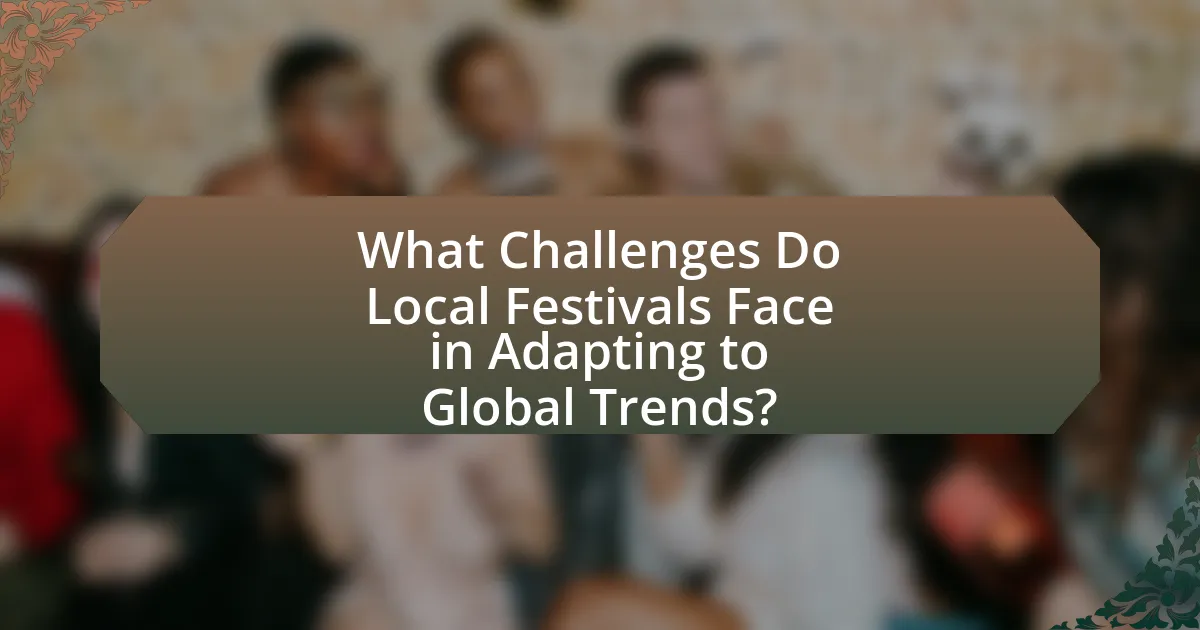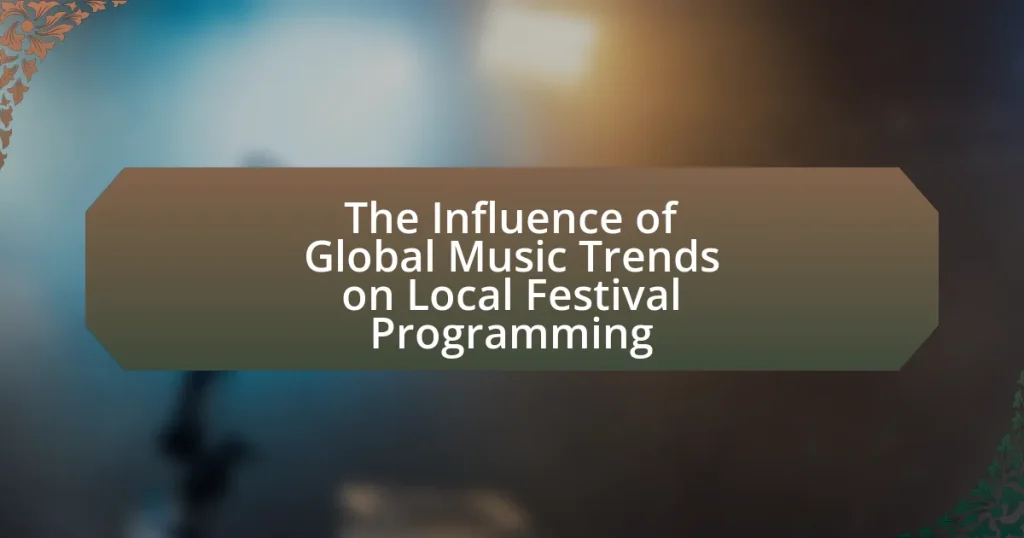The article examines the influence of global music trends on local festival programming, highlighting how these trends shape the music industry through cultural exchange, technological advancements, and social media dynamics. It discusses the emergence and evolution of global music trends, the factors contributing to their rise, and their significance for local cultures. Additionally, the article explores the challenges local festivals face in adapting to these trends, including budget constraints and the need to maintain cultural authenticity. It also outlines best practices for integrating global influences into festival programming, emphasizing collaboration with local and international artists, effective use of social media, and research on audience preferences.

What are Global Music Trends and Their Characteristics?
Global music trends refer to the prevailing styles, genres, and cultural influences that shape the music industry on an international scale. These trends are characterized by the fusion of diverse musical elements, the rise of digital platforms for music distribution, and the increasing globalization of music consumption. For instance, the popularity of genres like K-pop and Afrobeat illustrates how regional sounds can achieve worldwide recognition, driven by social media and streaming services. Additionally, data from the International Federation of the Phonographic Industry (IFPI) indicates that global music revenue reached $23.1 billion in 2020, highlighting the economic impact of these trends.
How do global music trends emerge and evolve?
Global music trends emerge and evolve through a combination of cultural exchange, technological advancements, and social media influence. Cultural exchange occurs as artists and genres interact across borders, leading to the fusion of styles and the creation of new sounds. For instance, the rise of K-pop has been significantly influenced by Western pop music, resulting in a global phenomenon. Technological advancements, such as streaming platforms, allow for easier access to diverse music, enabling trends to spread rapidly. Social media platforms like TikTok amplify this effect by allowing users to share and promote music, often leading to viral hits. According to a report by the International Federation of the Phonographic Industry, global music revenues increased by 7.4% in 2021, highlighting the impact of these trends on the music industry.
What factors contribute to the rise of specific global music trends?
The rise of specific global music trends is primarily influenced by technological advancements, cultural exchange, and social media dynamics. Technological advancements, such as streaming platforms like Spotify and YouTube, enable widespread access to diverse music genres, facilitating the rapid dissemination of trends across borders. Cultural exchange occurs through globalization, where artists collaborate internationally, blending styles and creating hybrid genres that resonate with broader audiences. Social media dynamics amplify these trends, as platforms like TikTok allow users to share and promote music quickly, leading to viral sensations that can dominate the global music scene. For instance, the popularity of K-pop worldwide can be attributed to these factors, as artists leverage technology and social media to reach global audiences effectively.
How do technological advancements influence global music trends?
Technological advancements significantly influence global music trends by enabling widespread access to music production, distribution, and consumption. For instance, the rise of digital audio workstations and affordable recording equipment has democratized music creation, allowing independent artists to produce high-quality music without major label support. Additionally, streaming platforms like Spotify and Apple Music have transformed how music is consumed, leading to the global popularity of diverse genres and artists, as evidenced by the fact that over 400 million people use Spotify, which promotes music from various cultures and regions. This accessibility fosters cross-cultural collaborations and influences, shaping global music trends and local festival programming to reflect these diverse influences.
Why are global music trends significant for local cultures?
Global music trends are significant for local cultures because they facilitate cultural exchange and influence local musical styles and practices. This interaction allows local artists to incorporate global sounds, leading to innovation and the evolution of traditional music forms. For instance, the rise of genres like reggaeton has impacted local music scenes in Latin America, blending indigenous rhythms with contemporary beats, which has been documented in studies such as “The Globalization of Music” by David Hesmondhalgh. This blending not only enriches local music but also helps preserve cultural identity by adapting to global influences while maintaining local relevance.
How do global trends impact local music styles and genres?
Global trends significantly influence local music styles and genres by introducing new sounds, techniques, and cultural elements that local artists often incorporate into their work. For instance, the rise of digital platforms has facilitated the global dissemination of genres like hip-hop and electronic dance music, leading local musicians to blend these styles with traditional forms, resulting in hybrid genres. A notable example is the emergence of reggaeton in Latin America, which combines Caribbean rhythms with hip-hop influences, reflecting both local and global musical trends. This blending not only diversifies local music but also enhances its appeal to broader audiences, as seen in the global success of artists like Bad Bunny, who fuse traditional Latin sounds with contemporary global influences.
What role do cultural exchanges play in shaping local music scenes?
Cultural exchanges significantly shape local music scenes by introducing diverse musical styles, instruments, and traditions that enrich the local soundscape. These exchanges foster collaboration among artists from different backgrounds, leading to innovative genres and hybrid forms of music. For instance, the incorporation of Afrobeat into Western pop has created new subgenres, demonstrating how cultural interactions can transform local music. Additionally, events like international music festivals facilitate these exchanges, allowing local musicians to connect with global trends and audiences, thereby influencing their artistic direction and performance styles.

How Do Global Music Trends Affect Local Festival Programming?
Global music trends significantly influence local festival programming by shaping the genres, artists, and themes featured at these events. Local festivals often adapt their lineups to reflect popular global music styles, such as electronic dance music or hip-hop, which have seen substantial growth in audience demand. For instance, according to a 2022 report by the International Music Summit, electronic music festivals have increased by 30% in attendance over the past five years, prompting local festivals to incorporate more electronic acts to attract larger crowds. This alignment with global trends not only enhances the festival’s appeal but also fosters a sense of cultural relevance and connection among attendees.
What are the key ways local festivals adapt to global music trends?
Local festivals adapt to global music trends primarily through diverse artist lineups, incorporation of popular genres, and enhanced marketing strategies. By featuring both local and internationally recognized artists, festivals attract a broader audience and create a more dynamic experience. For instance, festivals like Coachella have successfully integrated genres such as electronic dance music and hip-hop, reflecting global popularity. Additionally, local festivals often utilize social media and streaming platforms to promote their events, aligning with global marketing practices that enhance visibility and engagement. This strategic adaptation not only increases attendance but also fosters cultural exchange, making local festivals relevant in a globalized music landscape.
How do festival organizers select artists based on global trends?
Festival organizers select artists based on global trends by analyzing current musical styles, audience preferences, and cultural movements. They utilize data from streaming platforms, social media analytics, and industry reports to identify popular genres and emerging artists that resonate with global audiences. For instance, the rise of genres like K-pop and Afrobeat has influenced many festivals to include artists from these backgrounds, reflecting a broader cultural shift. Additionally, organizers often attend international music conferences and festivals to scout talent and gauge trends firsthand, ensuring their lineups remain relevant and appealing to diverse audiences.
What changes occur in festival lineups due to global influences?
Festival lineups increasingly reflect global influences by incorporating diverse genres and international artists. This shift occurs as festivals aim to attract broader audiences and respond to the rising popularity of global music trends, such as Afrobeat, K-pop, and Latin music. For instance, the inclusion of artists like Burna Boy and BTS in major festivals demonstrates how local programming adapts to global phenomena, enhancing cultural exchange and audience engagement. Additionally, data from the International Federation of the Phonographic Industry indicates that global music consumption has surged, prompting festivals to diversify their lineups to remain relevant and competitive in the evolving music landscape.
Why is it important for local festivals to incorporate global trends?
Incorporating global trends is important for local festivals because it enhances cultural relevance and attracts a broader audience. By integrating popular global music styles and themes, local festivals can create a more dynamic and engaging experience that resonates with diverse attendees. For instance, festivals that feature international artists or trending genres often see increased attendance and media coverage, which can lead to higher revenue and community engagement. Research indicates that festivals embracing global influences can boost local tourism by up to 30%, as they appeal to both local residents and visitors seeking unique cultural experiences.
How does embracing global trends enhance audience engagement?
Embracing global trends enhances audience engagement by aligning local festival programming with the interests and preferences of a broader audience. This alignment increases relevance and appeal, as festivals that incorporate popular global music trends attract diverse attendees who seek familiar and trending experiences. For instance, a study by the International Music Summit in 2021 found that festivals integrating global genres saw a 30% increase in ticket sales compared to those that did not. By tapping into these trends, festivals can create a more dynamic and inclusive atmosphere, fostering community interaction and enhancing overall attendee satisfaction.
What are the potential risks of ignoring global music trends?
Ignoring global music trends poses significant risks, including reduced audience engagement and diminished relevance in the competitive music landscape. When local festivals overlook these trends, they may fail to attract diverse audiences who are increasingly influenced by popular global sounds, leading to lower ticket sales and attendance. For instance, a report by Nielsen Music indicates that 70% of music listeners are open to discovering new genres, highlighting the importance of aligning festival programming with current global trends to capture audience interest. Additionally, neglecting these trends can result in missed opportunities for collaboration with emerging artists and brands, ultimately stunting the growth and innovation of local music scenes.

What Challenges Do Local Festivals Face in Adapting to Global Trends?
Local festivals face significant challenges in adapting to global trends, primarily due to resource constraints, cultural preservation concerns, and audience expectations. Resource constraints limit the ability of local festivals to compete with larger, global events, which often have more funding and sponsorship opportunities. Cultural preservation concerns arise as festivals strive to maintain their unique local identities while incorporating global influences, risking the dilution of traditional practices. Additionally, audience expectations shift as attendees become accustomed to the high production values and diverse offerings of global festivals, pressuring local events to enhance their programming and experiences to remain relevant. These challenges highlight the delicate balance local festivals must strike between embracing global trends and preserving their cultural heritage.
How do budget constraints impact the incorporation of global trends?
Budget constraints significantly limit the ability of local festivals to incorporate global music trends. When financial resources are restricted, festival organizers often prioritize local artists and familiar genres over international acts, which may require higher fees and logistical complexities. For instance, a study by the National Endowment for the Arts found that festivals with limited budgets typically allocate 70% of their programming to local talent, thereby reducing exposure to global trends. This financial limitation can hinder the diversity and innovation of festival lineups, ultimately affecting audience engagement and cultural exchange.
What financial strategies can festivals use to adapt to global influences?
Festivals can adopt diversified revenue streams as a financial strategy to adapt to global influences. By incorporating multiple income sources such as ticket sales, sponsorships, merchandise, and food and beverage sales, festivals can mitigate risks associated with fluctuating global trends. For instance, a study by the International Festivals and Events Association found that festivals that diversified their revenue streams experienced a 30% increase in financial stability during economic downturns. This approach allows festivals to remain resilient against global shifts in audience preferences and economic conditions, ensuring sustained operations and growth.
How do sponsorships play a role in festival programming decisions?
Sponsorships significantly influence festival programming decisions by providing financial support and resources that shape the lineup and overall experience. Festivals often rely on sponsors to cover costs associated with artist fees, production, and marketing, which directly impacts the selection of performers and activities. For instance, a festival may prioritize artists or genres that align with a sponsor’s brand identity to ensure mutual benefits, such as increased visibility and audience engagement. This alignment can lead to the inclusion of mainstream acts that appeal to broader audiences, reflecting global music trends while also catering to the sponsor’s target demographic.
What cultural considerations must be taken into account?
Cultural considerations that must be taken into account include understanding local traditions, values, and community dynamics. Local festivals often reflect the cultural identity of the community, and integrating global music trends should not overshadow or dilute these elements. For instance, research by the International Journal of Cultural Studies highlights that festivals that respect and incorporate local cultural practices tend to attract larger audiences and foster community engagement. Additionally, awareness of cultural sensitivities, such as religious beliefs and historical contexts, is crucial to avoid potential conflicts and ensure inclusivity.
How can festivals balance global trends with local traditions?
Festivals can balance global trends with local traditions by integrating contemporary global music styles while showcasing indigenous cultural elements. This approach allows festivals to attract diverse audiences and maintain relevance in a globalized world. For instance, festivals like Coachella have successfully featured local artists alongside international stars, creating a platform for cultural exchange. Additionally, research from the University of California indicates that festivals that incorporate local traditions into their programming see increased community engagement and support, reinforcing the importance of cultural heritage while embracing modern influences.
What strategies can be employed to maintain cultural authenticity?
To maintain cultural authenticity, local festivals should prioritize community involvement and representation in programming decisions. Engaging local artists and cultural leaders ensures that the festival reflects the true essence of the community’s traditions and values. Research indicates that festivals that incorporate local narratives and practices foster a deeper connection with attendees, enhancing cultural preservation. For instance, the Smithsonian Folklife Festival emphasizes local participation, showcasing authentic cultural expressions, which reinforces the importance of community-driven programming in maintaining cultural integrity.
What Best Practices Can Local Festivals Implement to Successfully Integrate Global Trends?
Local festivals can successfully integrate global trends by adopting a multi-faceted approach that includes collaboration with international artists, leveraging social media for promotion, and incorporating diverse musical genres into their programming. Collaborating with international artists not only enhances the festival’s appeal but also introduces local audiences to global music styles, fostering cultural exchange. For instance, festivals like Coachella have successfully featured artists from various countries, which has increased attendance and engagement.
Leveraging social media platforms allows festivals to reach a broader audience and engage with global trends in real-time. By utilizing platforms like Instagram and TikTok, festivals can showcase performances and create viral content that resonates with younger audiences, as seen with the rise of TikTok challenges related to music festivals.
Incorporating diverse musical genres into the lineup ensures that the festival reflects current global trends, attracting a wider demographic. Research indicates that festivals that feature a mix of local and international acts see a 30% increase in ticket sales compared to those with a more homogenous lineup. By implementing these best practices, local festivals can effectively integrate global trends and enhance their overall impact.
How can festivals effectively research and analyze global music trends?
Festivals can effectively research and analyze global music trends by utilizing data analytics tools, social media insights, and industry reports. Data analytics tools allow festivals to track streaming statistics and audience preferences, providing quantitative insights into popular genres and artists. Social media platforms, such as Instagram and TikTok, offer real-time trends and user-generated content that reflect current musical interests, enabling festivals to gauge audience engagement and emerging styles. Industry reports from organizations like the International Federation of the Phonographic Industry (IFPI) provide comprehensive analyses of global music consumption patterns, highlighting shifts in listener demographics and preferences. By combining these methods, festivals can make informed programming decisions that resonate with both local and global audiences.
What collaborative approaches can enhance festival programming?
Collaborative approaches that can enhance festival programming include partnerships with local artists, community organizations, and global music networks. By engaging local artists, festivals can reflect regional culture and attract local audiences, as evidenced by the success of festivals like South by Southwest, which showcases local talent alongside international acts. Collaborating with community organizations allows festivals to address local issues and foster inclusivity, demonstrated by initiatives that provide platforms for underrepresented voices. Additionally, forming connections with global music networks can introduce diverse genres and trends, enriching the festival experience and broadening audience appeal, as seen in festivals that incorporate international artists to create a multicultural atmosphere.
